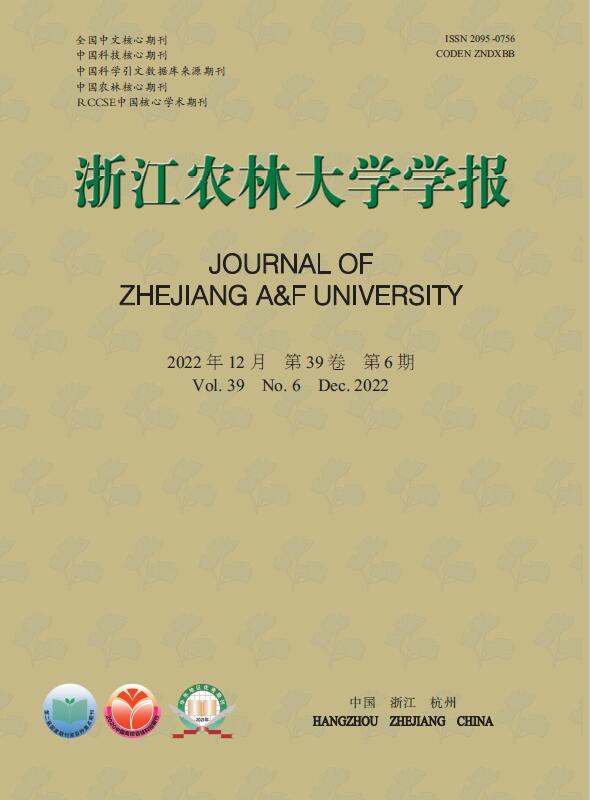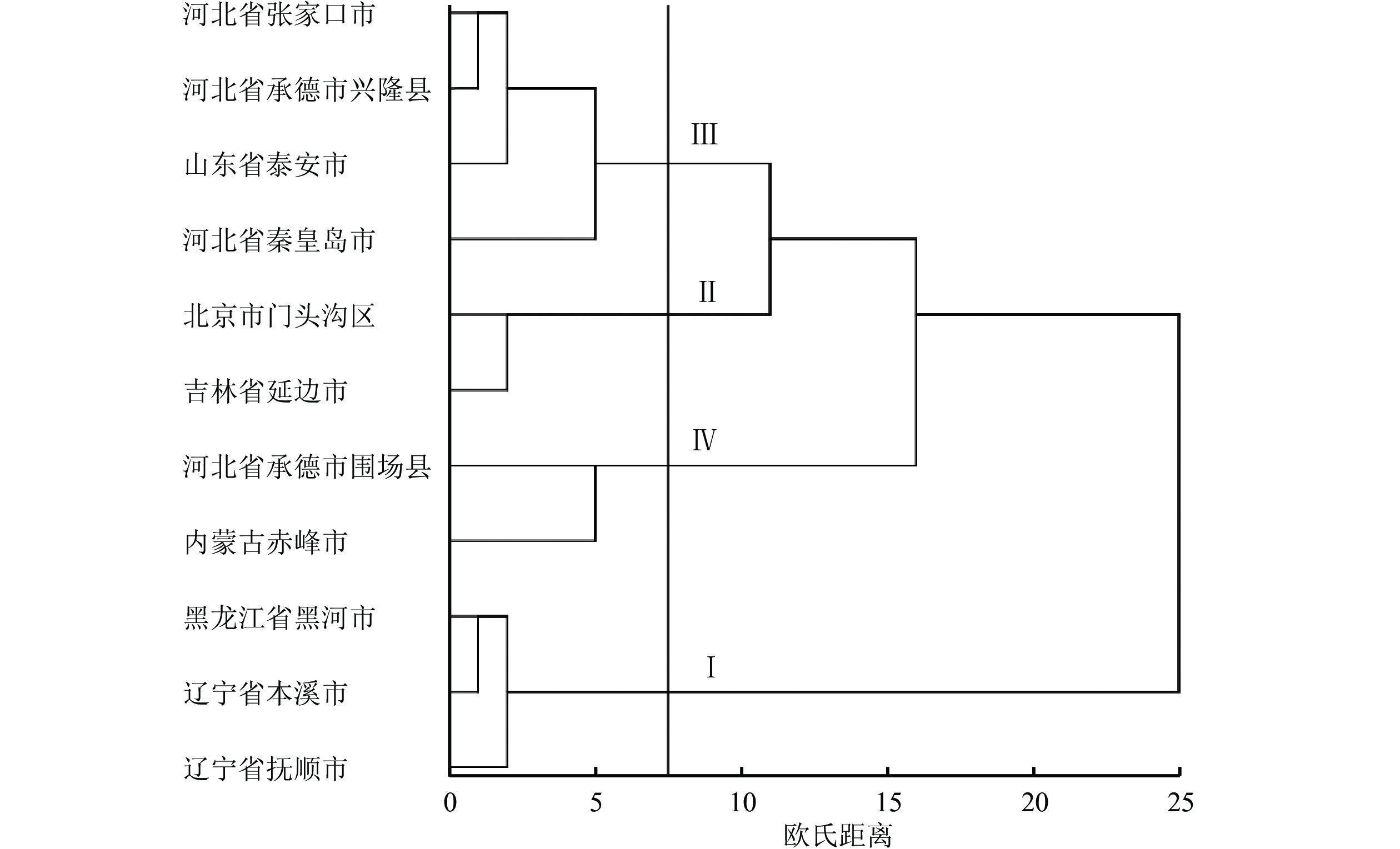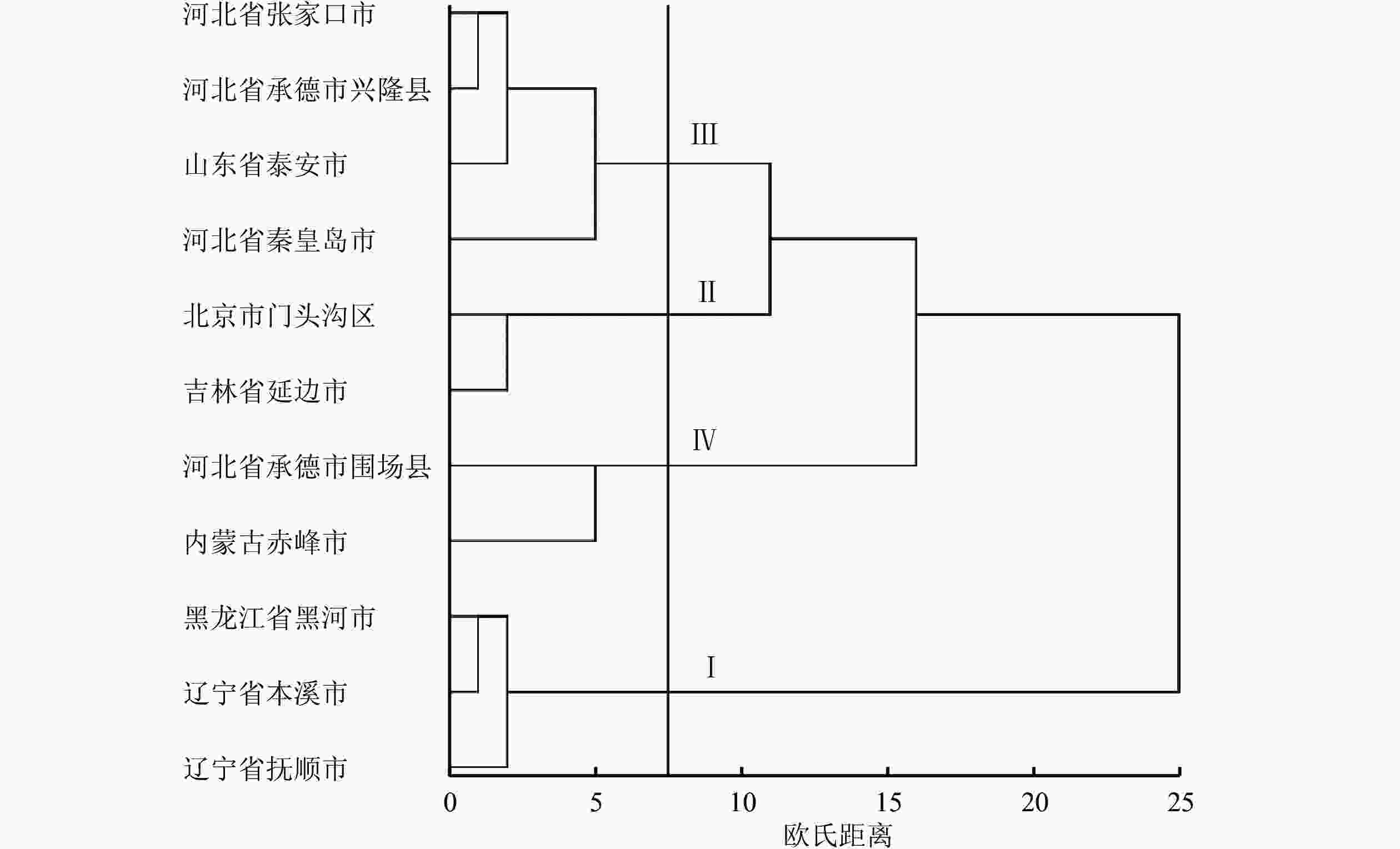-
蒙古栎Quercus mongolica为壳斗科Fagaceae栎属Quercus植物,广泛分布于寒温带、温带和暖温带地区[1]。距今2 000~7 000 a,以栎为主的栎类阔叶林和草甸是河北省平原地区的原生植被[2]。蒙古栎是重要的用材[3]、柞蚕[1, 4]、染料、栲胶[5]、食品、药用[6]、酿酒原料和景观树种,也是营造防风林、水源涵养林及防火林的优良树种,具有十分重要的经济、文化和生态功能。到目前为止,蒙古栎大多数处于野生状态,良种水平较为低下,良种选育研究仅限于对天然群体变异选种或以用材等为目的的种源试验研究阶段,而以结实为目的的良种选育研究尚未开始。因此,加强良种选育工作,提高蒙古栎的良种化水平迫在眉睫。
种子表型性状作为重要的经济性状[7],是遗传多样性的重要基础[8]。因此,对种子遗传变异进行分析显得尤为重要[9]。通过表型性状分析种质资源的遗传多样性直观易行,能够快速了解植物的遗传变异水平[10]。目前,针对东北三省(黑龙江省、辽宁省、吉林省)[11-12]及其他个别地区[13-14]蒙古栎不同种源的苗木生长情况、种子性状的分析研究较多,但对于全国蒙古栎不同种源的种子特性及环境因子的分析较少。本研究对全国蒙古栎天然分布区进行调查收集,了解现有蒙古栎的自然分布状况,采集种子作为种质资源保存,并对各种源收集的蒙古栎种子进行表型性状测定和统计分析,以期为蒙古栎种质资源收集、杂交育种及品种改良提供基础数据。
-
于2020年8—11月蒙古栎种子成熟期,在全国蒙古栎天然分布区调查并收集8省12个种源的蒙古栎种质资源,种源确定依据河北省洪崖山国有林场2018—2019年的全国蒙古栎种质资源踏查结果,结合厉月桥[15]关于蒙古栎分布的研究,选择蒙古栎主要天然分布区且具有优良林分的蒙古栎天然林,所选种源基本涵盖了蒙古栎主要天然分布区,可代表全国蒙古栎分布情况。所选采种林分为当地分布的天然林分,林龄>30 a,每个种源选取30株以上采种母树,母树间距50 m以上,收集的种子均已成熟饱满,无病虫害。蒙古栎不同种源的主要生态因子见表1。
种源编号 种源地 北纬(N) 东经(E) 海拔/m 年均气温/℃ 年降水量/mm 无霜期/d 1 黑龙江省黑河市 49°49′18″ 127°16′48″ 294 −1.0 525 110 2 辽宁省抚顺市 41°56′33″ 125°14′24″ 673 5.1 863 130 3 辽宁省本溪市 40°40′05″ 124°00′55″ 487 6.5 926 170 4 河北省张家口市 39°53′36″ 114°57′17″ 1 573 6.0 400 152 5 河北省承德市围场县 42°10′21″ 117°15′31″ 1 330 3.3 370 80 6 河北省承德市兴隆县 40°33′34″ 117°30′00″ 1 092 7.6 763 130 7 河北省秦皇岛市 40°08′33″ 119°25′28″ 1 110 8.9 741 180 8 北京市门头沟区 39°59′01″ 115°26′28″ 1 270 6.4 420 150 9 吉林省延边市 43°11′32″ 129°32′20″ 370 3.9 580 146 10 内蒙古赤峰市 42°06′57″ 118°19′36″ 1 175 7.7 559 157 11 山东省泰安市 53°27′05″ 117°16′20″ 868 13.0 750 200 Table 1. Main ecological factors of Q. mongolica from different provenances
-
8—9月,选取健壮植株,挂牌标记,拍摄植株照片,进行蒙古栎种质资源踏查,并准确记录采种地的经纬度、海拔及年均气温等;9—11月,收集挂牌标记且具代表性的蒙古栎植株种子。
-
分别对每个种源所采集的蒙古栎单株种子等量混合后,采用四分法随机选取300粒种子进行种长、种宽及种子单粒重、千粒重的测定,用电子游标卡尺进行蒙古栎种宽和种长的测定,精确到0.01 mm,用电子天平进行种子单粒重的测定,用百粒法测量种子千粒重,精确到0.01 g。
-
用Excel对测量的基础数据进行整理和统计;种形指数为种子的宽(直径)和长(纵径)之比[16];运用SPSS 11.5进行方差分析、相关分析(Pearson相关)、主成分分析;同时运用SPSS 11.5将原始数据进行标准化转换,采用欧式距离法进行聚类分析。
-
如表2所示:不同种源蒙古栎种长、种宽差异较大,种长为11.38~20.96 mm,种宽为11.07~17.80 mm。其中辽宁省抚顺市蒙古栎种子的种长和种宽最长,均值分别为20.96、17.80 mm,其种宽、单粒重显著高于其他地区(P<0.05);内蒙古赤峰市最低,种长和种宽均值分别为11.38、11.07 mm,显著低于其他地区(P<0.05)。河北省承德市围场县与兴隆县蒙古栎种子的种长、种宽无显著差异。种形指数均存在一定差异,但差异较小,其中河北省秦皇岛市最高,山东省泰安市最低,均值分别为1.28、1.02。
种源地 种长/mm 种宽/mm 种形指数 单粒重/g 千粒重/g 黑龙江省黑河市 20.94±0.38 a 16.58±0.44 bc 1.26±0.04 ab 2.93±0.07 ab 2 949.41±9.65 b 辽宁省抚顺市 20.96±0.73 a 17.80±0.71 a 1.18±0.01 ab 3.05±0.16 a 3 027.39±7.74 a 辽宁省本溪市 18.37±0.46 bc 15.46±0.64 d 1.20±0.02 ab 2.83±0.02 b 2 878.82±7.03 c 河北省张家口市 16.47±0.51 de 13.11±0.68 f 1.26±0.10 ab 1.82±0.10 e 1 824.11±9.20 h 河北省承德市围场县 16.49±0.50 de 13.94±0.23 ef 1.17±0.12 ab 1.41±0.07 f 1 482.71±1.36 j 河北省承德市兴隆县 16.18±0.22 e 14.01±0.49 ef 1.15±0.01 abc 1.79±0.07 e 1 765.37±4.14 i 河北省秦皇岛市 18.22±0.88 c 14.29±0.23 e 1.28±0.04 a 2.07±0.06 d 2 075.77±2.53 f 北京市门头沟区 19.38±1.19 b 16.02±0.97 cd 1.21±0.10 ab 2.31±0.11 c 2 310.59±7.58 e 吉林省延边市 19.39±0.23 b 17.26±0.19 ab 1.12±0.02 bcd 2.45±0.07 c 2 421.51±2.44 d 内蒙古赤峰市 11.38±0.38 f 11.07±0.81 g 1.03±0.09 cd 1.22±0.09 g 1 244.40±5.51 k 山东省泰安市 17.40±1.04 cd 17.10±0.42 abc 1.02±0.09 d 1.92±0.03 de 1 926.28±1.40 g 说明:同列不同字母表示不同种源地之间差异显著(P<0.05) Table 2. Difference analysis of seeds phenotypic characters in Q. mongolica from different provenances
单粒重和千粒重差异较大,其中各种源千粒重之间均存在显著差异(P<0.05),最高为辽宁省抚顺市(3 027.39 g),最低为内蒙古赤峰市(1 244.40 g),可以看出千粒重的变异幅度较大。
-
如表3所示:不同种源蒙古栎种子表型性状存在一定的相关性。其中蒙古栎种子的种长、种宽、单粒重、千粒重相互之间均存在极显著正相关(P<0.01),即种长越长,种宽越宽,单粒重和千粒重随着种长、种宽的增大而增加,表明这4个表型性状是相互影响的。种形指数与种长、种宽、单粒重和千粒重的相关性呈不显著正相关。
性状 种长 种宽 种形指数 单粒重 千粒重 种长 1.00 0.88** 0.52 0.88** 0.88** 种宽 1.00 0.06 0.79** 0.78** 种形指数 1.00 0.40 0.41 单粒重 1.00 1.00** 说明:**表示极显著相关(P<0.01) Table 3. Correlation of seeds phenotypic characters in Q. mongolica from different provenances
-
从不同种源蒙古栎种子表型性状与生态因子之间的相关性分析(表4)可知:海拔与种宽呈显著负相关(P<0.05),与单粒重、千粒重呈极显著负相关(P<0.01),相关系数达−0.67、−0.75、−0.75,即海拔越高,种宽、单粒重和千粒重越小。东经与千粒重、单粒重呈显著正相关(P<0.05),相关系数均达0.72,即随着经度的增加,单粒重、千粒重增大。无霜期与单粒重呈正相关,即无霜期越长,单粒重越大。种长、种形指数与生态因子之间也存在一定的相关性,但差异不显著,说明蒙古栎种子表型性状的差异与种源生态环境因子有一定的相关性,即存在地理变异特性。
生态因子 种长 种宽 种形指数 单粒重 千粒重 东经 0.56 0.58 0.06 0.72* 0.72* 北纬 0.18 0.44 −0.41 0.13 0.13 海拔 −0.57 −0.67* 0.07 −0.75** −0.75** 年均气温 −0.41 −0.15 −0.50 −0.40 −0.41 年降水量 0.20 0.34 −0.17 0.45 0.45 无霜期 −0.13 0.05 −0.29 0.01 −0.01 说明:*表示显著相关(P<0.05);**表示极显著相关(P<0.01) Table 4. Correlation between seeds phenotypic characters in Q. mongolica and ecological factors from different provenances
-
以11个种源间蒙古栎种子相关特性为样本,将种子5个表型性状和6个生态因子数据进行主成分分析。由表5可知:特征值大于1有3个主成分,贡献率分别为43.78%、22.92%、12.57%,累计贡献率达79.27%。其中,第1主成分特征值为5.37,对应的特征向量千粒重和单粒重最大,均为0.41。可以把第1主成分称为种子质量因子。第2主成分特征值为2.52,对应的特征向量无霜期最大,为0.51,可以把第2主成分称为环境因子;第3主成分特征值为1.38,对应的特征向量北纬最小,可以把第3主成分称为地理因子。综上可知,影响蒙古栎种子特性的因素从大到小为单粒重、千粒重、无霜期、北纬。
主成分 特征向量 特征值 贡献率/% 累计贡献率/% 种长 种宽 种形指数 单粒重 千粒重 东经 北纬 海拔 年均气温 年降水量 无霜期 1 0.38 0.37 0.13 0.41 0.41 0.36 0.12 −0.37 −0.21 0.18 −0.04 5.37 43.78 43.78 2 −0.09 0.14 −0.42 0.00 0.00 0.00 0.29 −0.15 0.50 0.42 0.51 2.52 22.92 66.70 3 0.16 −0.04 0.47 0.19 0.18 −0.24 −0.55 0.26 0.26 0.28 0.32 1.38 12.57 79.27 Table 5. Principal component analysis of seeds related characteristics in Q. mongolica from different provenances
-
由聚类分析结果(图1)可以看出:根据单粒重和千粒重,不同种源蒙古栎共分为4类,分别为Ⅰ、Ⅱ、Ⅲ和Ⅳ类种群,其中黑龙江省黑河市、辽宁省本溪市、辽宁省抚顺市为Ⅰ类,种子的单粒重和千粒重远高于所有种源的均值,为最优种源;北京市门头沟区、吉林省延边市为Ⅱ类,单粒重和千粒重略高于均值;河北省张家口市、河北省承德市兴隆县、山东省泰安市、河北省秦皇岛市为Ⅲ类,单粒重和千粒重略低于均值;河北省承德市围场县、内蒙古赤峰市为Ⅳ类,单粒重和千粒重最小。从聚类分析结果看,蒙古栎种子表型性状表现出了一定的区域性,天然种源基本上分布于东北部地区,Ⅰ类分布于东部偏冷地区,Ⅱ类分布于东部和北部地区,Ⅲ类分布于中部地区(华北和华东),Ⅳ类分布于北部地区,表现出从东北向西南的走向,种源质量逐渐降低,这与相关性分析结果相吻合。
-
种质资源的调查和评价是研究品种起源、演化和驯化的基础,对优异资源筛选、品种选育具有重要意义[17]。本研究通过对蒙古栎种子5种表型性状的测定和分析,得出不同种源蒙古栎种实表型性状之间存在差异,其中种长、千粒重均存在显著差异(P<0.05),这与厉月桥等[18]对蒙古栎、李迎超[19]对栓皮栎Q. variabilis、麻栎Q. acutissima的研究结果一致,且种长与种宽、单粒重、千粒重之间均存在极显著正相关(P<0.01),表明蒙古栎种质资源丰富,各生长性状在种源间存在较大的遗传改良潜力。
植物与其生存环境的关系一直是关注的热点[20],处于不同生态环境的同种物种,经过长期对当地生境的适应,发生了地理变异,形成了不同的地理种源[21]。蒙古栎地理分布较为广泛,生存环境存在较大差异。气候条件,如气温、水分等对植物的有性繁殖有着重要的影响[22],海拔等对种子、果实的品质也具有影响[23-27],而气候条件的波动及其他环境条件的改变会影响物种更新和种群动态[28-30]。本研究表明:蒙古栎不同种源种子表型特征与生态因子之间均存在相关性,其中海拔与种宽存在显著负相关,这与厉月桥等[18]对蒙古栎研究结果相同,单粒重和千粒重受分布区海拔的影响存在垂直变异,说明蒙古栎具有广泛的适应性,随着环境条件的变化,出现遗传变异。这与李斌等[31]对白皮松Pinus bungeana及张清等[32]对铁橡栎Quercus cocciferoides的研究结果一致,即变异越大,适应环境的能力就越强。单粒重与东经存在显著正相关,随着经度的降低,单粒重和千粒重逐渐降低,种形指数无显著变化,种源质量相对降低,可能由于种子储藏营养物质的量直接影响幼苗建植,大种子有利于幼苗建植早期根系的发育和生物量的积累[33],从而具有更强的生长势、逆境耐受能力和对资源的竞争能力[34]。种子的形状与种长和年均气温的相关性较大,说明蒙古栎种子形状受自身遗传物质控制,同时也受周边环境因子的影响,存在地理变异,由于长期生长在生态条件明显不同的地区,蒙古栎种源间可能产生遗传分化,这与相关的研究结果[15, 35]一致。
-
本研究表明:影响种子特性的因素按照重要性从大到小依次为单粒重、千粒重、无霜期、北纬。主成分分析表明:贡献率最大的第1主成分表征的特征向量为单粒重和千粒重,因此可将单粒重和千粒重作为快速筛选种源优良与否的优先筛选指标,这与常恩福等[36]对铁橡栎的研究结果一致。第2、3主成分主要为环境因子和地理因子,这与常恩福等[36]、张清等[32]的研究结果存在差异。常恩福等[36]研究表明:第2、3、4主成分是种形指数、纬度和海拔,即形状因子和生态环境因子;张清等[32]研究表明:第2主成分为种形指数,可能与树种特性及分布范围存在一定关系。
根据种子性状的综合聚类分析结果,将11个种源按单粒重和千粒重聚为4类,地理分布相近的种源并没有聚在一起,说明了种源间表型性状变异不具有连续性。Ⅰ类种群中,黑河同辽宁地理位置距离较大,但聚为同一类群,可能由于其经度相似,经度和千粒重、单粒重呈显著正相关有关,这与李文文[37]对蒙古栎种源变异的研究结果一致。Ⅱ类和Ⅲ类种群中,河北和山东相隔距离较大,可能由于同一类群在不同种源之间地形起伏较大,形成了一定程度上的地理隔离,从而造成同一类群的种源,地理距离反而较大,这与李文文[37]的研究结果一致。Ⅲ类种群除山东泰安外,均位于河北地区,地理距离相对集中,且与Ⅳ类种群相隔地理距离较小,单粒重和千粒重均低于均值,种源质量相对较差。
其中Ⅰ类种群在种源质量方面优于Ⅱ、Ⅲ和Ⅳ类,Ⅰ类分布区均为蒙古栎集中分布区[15],同时根据蒙古栎适生分布区的研究可知:不同种源间地理梯度变异明显,呈东北—西南走向,这与李斌等[31]对白皮松的研究结果相同。
只通过5种表型性状特征确定各种源之间的表型差异存在一定的局限性,因此,还需进一步连续多年收集测定或继续开展分子水平方面的研究,深入分析蒙古栎不同种源之间的遗传变异。
Diversity of phenotypic characters of Quercus mongolica seeds from different provenances
doi: 10.11833/j.issn.2095-0756.20220133
- Received Date: 2022-01-21
- Accepted Date: 2022-05-26
- Rev Recd Date: 2022-05-11
- Available Online: 2023-06-05
- Publish Date: 2022-12-20
-
Key words:
- Quercus mongolica /
- provenances /
- phenotypic characters /
- diversity /
- ecological factors
Abstract:
| Citation: | REN Junjie, PANG Xinbo, LIU Zhaoyang, et al. Diversity of phenotypic characters of Quercus mongolica seeds from different provenances[J]. Journal of Zhejiang A&F University, 2022, 39(6): 1221-1228. DOI: 10.11833/j.issn.2095-0756.20220133 |











 DownLoad:
DownLoad: